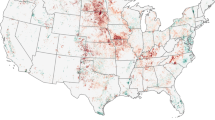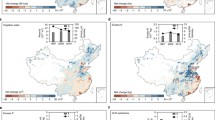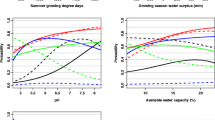Abstract
Land area planted to row crops has expanded globally with increased demand for food and biofuels. Agricultural expansion in the Dakota Prairie Pothole Region (DPPR), USA affects a variety of agricultural and non-agricultural land-use types, including grasslands and wetlands that provide critical wildlife habitat and other ecosystem services. The purpose of this study was to quantify recent changes in rural land cover/land use, analyze trends, and interpret results in relation to climate, agronomic practice, and ethanol production. The primary data sources were 1980–2012 statewide cropland data from the U.S. Department of Agriculture (USDA) National Agricultural Statistics Service, and the USDA Cropland Data Layer, produced annually for the DPPR from 2006 through 2012. Area planted to corn or soybean row crops increased, and small grain (e.g., wheat, barley) area decreased significantly over the analysis period. Corn and soybean expanded by 27 % in the DPPR between 2010 and 2012 alone, an areal increase (+15,400 km2) larger than the U.S. state of Connecticut. This expansion displaced primarily small grains and grassland (e.g., pastures, haylands, remnant prairies). Grassland regularly exchanged land with corn and soybean, small grains, and wetlands and water. Corn and soybean had high inter-annual self-replacement values (68–80 %), and continuous corn/soy row cropping was the second most common combination over a three-year period, ranking after continuous grassland. Small grain self-replacement values were only 22–35 %, indicating frequent relocation in the landscape. Temporary gains in wetland and grassland area were attributed to unusually wet climatic conditions and late snowfalls that prevented crop planting. Nearly all of the region’s ethanol refineries were located where corn and soybean crops constituted 50 % or more of the land area. Quantification of grassland losses in the U.S. Northern Plains requires evaluation of all land uses that interact with grasslands, and a longer term perspective that incorporates grassland as part of a normal land-use rotation.








Similar content being viewed by others
References
Akyüz A, Mullen BA (2011) 2011 growing season weather summary for North Dakota. North Dakota State Climate Office, Fargo
Atwell RC, Schulte LA, Westphal LM (2009) Landscape, community, countryside: linking biophysical and social scales in US Corn Belt agricultural landscapes. Landscape Ecol 24(6):791–806
Beck R (2013) Benefits of wheat in a corn soybean rotation. South Dakota State University, Brookings, SD. http://igrow.org/agronomy/wheat/benefits-of-wheat-in-a-corn-soybean-rotation/ Accessed Aug 2013
Boryan C, Yang Z, Mueller R, Craig M (2011) Monitoring US agriculture: the US Department of Agriculture, National Agricultural Statistics Service, Cropland Data Layer Program. Geocarto International 26(5):341–358
U.S. Census Bureau (2010) State and County QuickFacts. U.S. Department of Commerce, Washington DC. http://quickfacts.census.gov/qfd/index.html Accessed Aug 2013
Culman SW, Young-Mathews A, Hollander AD et al (2010) Biodiversity is associated with indicators of soil ecosystem functions over a landscape gradient of agricultural intensification. Landscape Ecol 25(9):1333–1348
Cunningham MA (2006) Accuracy assessment of digitized and classified land cover data for wildlife habitat. Landscape Urban Plan 78(3):217–228
Cunningham MA, Johnson DH (2006) Proximate and landscape factors influence grassland bird distributions. Ecol Appl 16(3):1062–1075
Dale VH, Kline KL, Kaffka SR, Langeveld JWA (2013) A landscape perspective on sustainability of agricultural systems. Landscape Ecol 28(6):1111–1123
Faber S, Rundquist S, Male T (2012) Plowed under: how crop subsidies contribute to massive habitat losses. Environmental Working Group, Washington DC
Fang S, Gertner G, Wang G, Anderson A (2006) The impact of misclassification in land use maps in the prediction of landscape dynamics. Landscape Ecol 21(2):233–242
Feather P, Hellerstein D, Hansen L (1999) Economic valuation of environmental benefits and the targeting of conservation programs: the case of the CRP. Agricultural Economic Report No. AER-778, U.S. Department of Agriculture Economic Research Service, Agricultural Economic Report No. AER-778, Washington, DC, USA
U.S. GAO (2007) Agricultural conservation: farm program payments are an important factor in landowners’ decisions to convert grassland to cropland. GAO-07-1054 Report to Congressional Requesters, United States Government Accountability Office, Washington DC
Gray ME, Sappington TW, Miller NJ, Moeser J, Bohn MO (2009) Adaptation and invasiveness of western corn rootworm: intensifying research on a worsening pest. Annu Rev Entomol 54(1):303–321
Houet T, Loveland TR, Hubert-Moy L et al (2010) Exploring subtle land use and land cover changes: a framework for future landscape studies. Landscape Ecol 25(2):249–266
Johnston CA (2013) Wetland losses due to row crop expansion in the Dakota Prairie Pothole Region. Wetlands 33(1):175–182
Landis DA, Gardiner MM, van der Werf W, Swinton SM (2008) Increasing corn for biofuel production reduces biocontrol services in agricultural landscapes. Proc Natl Acad Sci 105(51):20552–20557
Langpap C, Wu J (2011) Potential environmental impacts of increased reliance on corn-based bioenergy. Environ Resour Econ 49(2):147–171
McLauchlan KK, Hobbie SE, Post WM (2006) Conversion from agriculture to grassland builds soil organic matter on decadal timescales. Ecol Appl 16(1):143–153
Mehaffey M, Smith E, Van Remortel R (2011) Midwest U.S. landscape change to 2020 driven by biofuel mandates. Ecol Appl 22(1):8–19
National Research Council (2003) Frontiers in agricultural research: food, health, environment, and communities. National Academy Press, Washington DC
NCDC (2013) Plot time series. National Climatic Data Center, NOAA, Asheville, NC. http://www.ncdc.noaa.gov/temp-and-precip/time-series/ Accessed Aug 2013
NDSU (1997) Corn production guide. NDSU Extension Service, North Dakota State University of Agriculture and Applied Science, Fargo
Polasky S, Nelson E, Pennington D, Johnson K (2011) The impact of land-use change on ecosystem services, biodiversity and returns to landowners: a case study in the State of Minnesota. Environ Resour Econ 48(2):219–242
Powles SB (2008) Evolved glyphosate-resistant weeds around the world: lessons to be learnt. Pest Manag Sci 64(4):360–365
R Core Team (2013) R: a language and environment for statistical computing. R Foundation for Statistical Computing, Vienna
Ransom J (2004) Basics of corn production in North Dakota. A-834, NDSU Extension Service, North Dakota State University of Agriculture and Applied Science, Fargo
Reynolds RE, Shaffer TL, Renner RW, Newton WE, Batt BDJ (2001) Impact of the Conservation Reserve Program on duck recruitment in the U.S. Prairie Pothole Region. J Wildl Manag 65(4):765–780
Riseng CM, Wiley MJ, Black RW, Munn MD (2011) Impacts of agricultural land use on biological integrity: a causal analysis. Ecol Appl 21(8):3128–3146
Rodionov SN (2006) Sequential regime shift detection, version 3.2 (software add-into Excel 2002). NOAA Pacific Marine Environmental Laboratory, Seattle, WA, USA. http://www.beringclimate.noaa.gov/regimes/ Accessed Aug 2013
Samson FB, Knopf FL, Ostlie WR (2004) Great Plains ecosystems: past, present, and future. Wildl Soc Bull 32(1):6–15
Searchinger T, Heimlich R, Houghton RA et al (2008) Use of U.S. croplands for biofuels increases greenhouse gases through emissions from land-use change. Science 319(5867):1238–1240
Secchi S, Gassman PW, Jha M, Kurkalova L, Kling CL (2011) Potential water quality changes due to corn expansion in the Upper Mississippi River Basin. Ecol Appl 21(4):1068–1084
Shao G, Wu J (2008) On the accuracy of landscape pattern analysis using remote sensing data. Landscape Ecol 23(5):505–511
Stephens SE, Rotella JJ, Lindberg MS, Taper ML, Ringelman JK (2005) Duck nest survival in the Missouri Coteau of North Dakota: landscape effects at multiple spatial scales. Ecol Appl 15(6):2137–2149
Stephens SE, Walker JA, Blunck DR et al (2008) Predicting risk of habitat conversion in native temperate grasslands. Conserv Biol 22(5):1320–1330
Tan ZX, Liu SG, Johnston CA et al (2005) Soil organic carbon dynamics as related to land use history in the northwestern Great Plains. Glob Biogeochem Cycles 19(3):GB3011
Tilman D, Balzer C, Hill J, Befort BL (2011) Global food demand and the sustainable intensification of agriculture. Proc Natl Acad Sci 108(50):20260–20264
U.S. Energy Information Administration (2013) South Dakota state energy profile. http://www.eia.gov/state/?sid=SD Accessed Aug 2013
USDA NASS (2012) Crop Production (November 2012). USDA, National Agricultural Statistics Service, Washington DC
USDA ERS (2013) Crops. U.S. Department of Agriculture, Economic Research Service, Washington DC, USA. http://www.ers.usda.gov/topics/crops.aspx Accessed Aug 2013
USDA NASS (2013) Statistics by state. U.S. Department of Agriculture, National Agricultural Statistics Service, Washington DC. http://www.nass.usda.gov/Statistics_by_State/ Accessed Aug 2013
Vaché KB, Eilers JM, Santelmann MV (2002) Water quality modeling of alternative agricultural scenarios in the U.S. corn belt. JAWRA. J Am Water Resour Assoc 38(3):773–787
Wallander S, Claassen R, Nickerson C (2011) The ethanol decade: an expansion of U.S. corn production, 2000–2009. EIB-79, USDA Economic Research Service, Washington DC
West TO, Post WM (2002) Soil organic carbon sequestration rates by tillage and crop rotation. Soil Sci Soc Am J 66(6):1930–1946
Wright CK, Wimberly MC (2013) Recent land use change in the Western Corn Belt threatens grasslands and wetlands. Proc Natl Acad Sci 110(10):4134–4139
Wu Y, Liu S, Li Z (2012) Identifying potential areas for biofuel production and evaluating the environmental effects: a case study of the James River Basin in the Midwestern United States. GCB Bioenergy 4(6):875–888
Acknowledgments
Lisa Schulte and two anonymous reviewers are thanked for comments that improved the quality of this manuscript.
Author information
Authors and Affiliations
Corresponding author
Electronic supplementary material
Below is the link to the electronic supplementary material.
10980_2013_9947_MOESM1_ESM.pdf
Supplementary material 1 (PDF 11 kb) Appendix 1. Palmer Hydrological Drought Index for North and South Dakota, March single month values for 2004-2013 (NCDC 2013)
10980_2013_9947_MOESM2_ESM.tif
Supplementary material 2 (TIFF 3483 kb) Appendix 2. Location of gains in corn/soy land within the DPPR, based on 2011-2012 CDL data. Values are the proportion of land area that became new corn/soy. Values ≤ 0 lost corn/soy land or were unchanged; positive values gained corn/soy land
Rights and permissions
About this article
Cite this article
Johnston, C.A. Agricultural expansion: land use shell game in the U.S. Northern Plains. Landscape Ecol 29, 81–95 (2014). https://doi.org/10.1007/s10980-013-9947-0
Received:
Accepted:
Published:
Issue Date:
DOI: https://doi.org/10.1007/s10980-013-9947-0




